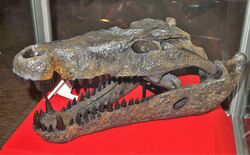Biology:Mekosuchinae
| Mekosuchinae | |
|---|---|

| |
| Restoration of the skull of Quinkana timara at the Central Australian Museum | |
| Scientific classification | |
| Domain: | Eukaryota |
| Kingdom: | Animalia |
| Phylum: | Chordata |
| Class: | Reptilia |
| Clade: | Archosauromorpha |
| Clade: | Archosauriformes |
| Order: | Crocodilia |
| Clade: | †Mekosuchinae Willis, Molnar & Scanlon, 1993 |
| Type species | |
| †Mekosuchus inexpectatus Balouet & Buffetaut, 1987
| |
| Genera | |
Mekosuchinae is an extinct clade of crocodilians from the Cenozoic of Australasia. They represented the dominant group of crocodilians in the region during most of the Cenozoic.[1] They first appear in the fossil record in the Eocene in Australia, and survived until the arrival of humans: in the Late Pleistocene in Australia and within the Holocene in the Pacific islands of Fiji, New Caledonia and Vanuatu.
Mekosuchine crocodiles are a diverse group. One of the last species, Mekosuchus inexpectatus from Holocene New Caledonia, may have been arboreal.[2] The early Miocene species Harpacochampsa camfieldensis may have resembled a false gharial. Another mekosuchine fossil, currently undescribed, has been found in Miocene deposits from New Zealand. One genus, Mekosuchus, managed to spread to the islands of the Pacific; it is believed to have island-hopped across the Coral Sea, moving first to a now submerged island known as Greater Chesterfield Island, then New Caledonia and onwards. In the Pleistocene, Quinkana was one of the top terrestrial predators of the Australian continent.
Mekosuchines underwent a drastic decline in post-Miocene Australia, with all genera, except for Quinkana and Paludirex (both perishing during the Quaternary extinction event) becoming extinct in Australia by the end of the Pliocene. After the demise of Quinkana and Pallimnarchus, the group survived on Vanuatu and New Caledonia until the arrival of humans, who are presumed to have driven them to extinction.
While historically considered to be true crocodiles (of the family Crocodylidae), modern research places them as an independent group within or closely related to Longirostres, which contains both crocodiles and gavialids.[1]
Phylogeny
Mekosuchinae is cladistically defined as a node-based taxon composed of the last common ancestor of Kambara implexidens, Mekosuchus inexpectatus, and all of its descendants.[3]
Mekosuchinae is traditionally thought to be included as a basal member Crocodyloidea,[4] although this is disputed.[5] A 2018 tip dating study by Lee & Yates simultaneously using morphological, molecular (DNA sequencing), and stratigraphic (fossil age) data established the inter-relationships within Crocodilia,[5] which was expanded upon in 2021 by Hekkala et al. using paleogenomics by extracting DNA from the extinct Voay.[6]
The below cladogram shows the results of the Lee and Yates study (2018), which placed Mekosuchinae outside of Crocodyloidea, as more basal than Longirostres (the combined group of crocodiles and gavialids).[5]
| Crocodylia |
| ||||||||||||||||||||||||||||||||||||||||||||||||||||||||||||||||||||||||||||||||||||||||||||||||||||||||||||||||||||||||||||||||||||||||||||||||||||||||||||
Other studies have recovered Mekosuchinae within Longirostres, belonging to Crocodyloidea, as shown in the alternative cladogram below.[1]
| |||||||||||||||||||||||||||||||||||||||||||||||||||||||||||||||||||||||||||||||||||||||||||||||||||||||||||||||||||||||||||||||||||||||||||||||||||||||||||||||||||||||||||||||||||||||||||||||||||||||||||||||||||||||||||||||||||||||||||||||||||||||
References
- ↑ 1.0 1.1 1.2 Ristevski, Jorgo; Weisbecker, Vera; Scanlon, John D.; Price, Gilbert J.; Salisbury, Steven W. (February 2023). "Cranial anatomy of the mekosuchine crocodylian Trilophosuchus rackhami Willis, 1993" (in en). The Anatomical Record 306 (2): 239–297. doi:10.1002/ar.25050. ISSN 1932-8486. PMID 36054424.
- ↑ Naish, Darren (13 May 2009). "The small, recently extinct, island-dwelling crocodilians of the south Pacific". Tetrapod Zoology. ScienceBlogs. http://scienceblogs.com/tetrapodzoology/2009/05/13/mekosuchines-2009/.
- ↑ Rio, Jonathan P.; Mannion, Philip D. (6 September 2021). "Phylogenetic analysis of a new morphological dataset elucidates the evolutionary history of Crocodylia and resolves the long-standing gharial problem". PeerJ 9: e12094. doi:10.7717/peerj.12094. PMID 34567843.
- ↑ Stein, Michael D.; Yates, Adam; Hand, Suzanne J.; Archer, Michael (2017). "Variation in the pelvic and pectoral girdles of Australian Oligo–Miocene mekosuchine crocodiles with implications for locomotion and habitus". PeerJ 5: e3501. doi:10.7717/peerj.3501. PMID 28674657.
- ↑ 5.0 5.1 5.2 Michael S. Y. Lee; Adam M. Yates (27 June 2018). "Tip-dating and homoplasy: reconciling the shallow molecular divergences of modern gharials with their long fossil". Proceedings of the Royal Society B 285 (1881). doi:10.1098/rspb.2018.1071. PMID 30051855.
- ↑ Hekkala, E.; Gatesy, J.; Narechania, A.; Meredith, R.; Russello, M.; Aardema, M. L.; Jensen, E.; Montanari, S. et al. (2021-04-27). "Paleogenomics illuminates the evolutionary history of the extinct Holocene "horned" crocodile of Madagascar, Voay robustus" (in en). Communications Biology 4 (1): 505. doi:10.1038/s42003-021-02017-0. ISSN 2399-3642. PMID 33907305.
- Mead, J. I.; Steadman, D. W.; Bedford, S. H.; Bell, C. J.; Spriggs, M. (August 2002). Guyer, C.. ed. "New extinct mekosuchine crocodile from Vanuatu, South Pacific". Copeia 2002 (3): 632–641. doi:10.1643/0045-8511(2002)002[0632:NEMCFV2.0.CO;2]. http://doc.rero.ch/record/16396/files/PAL_E3562.pdf.
Wikidata ☰ Q137778 entry
 |


